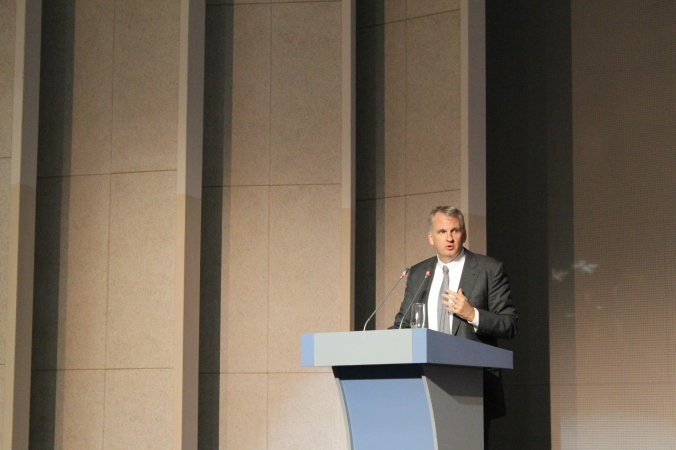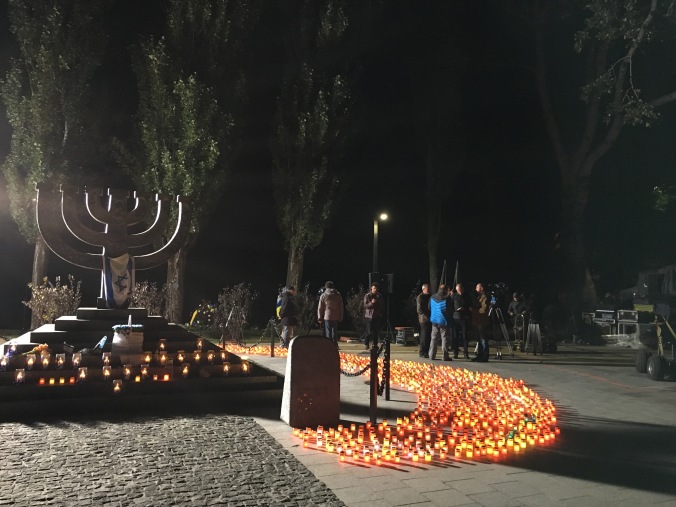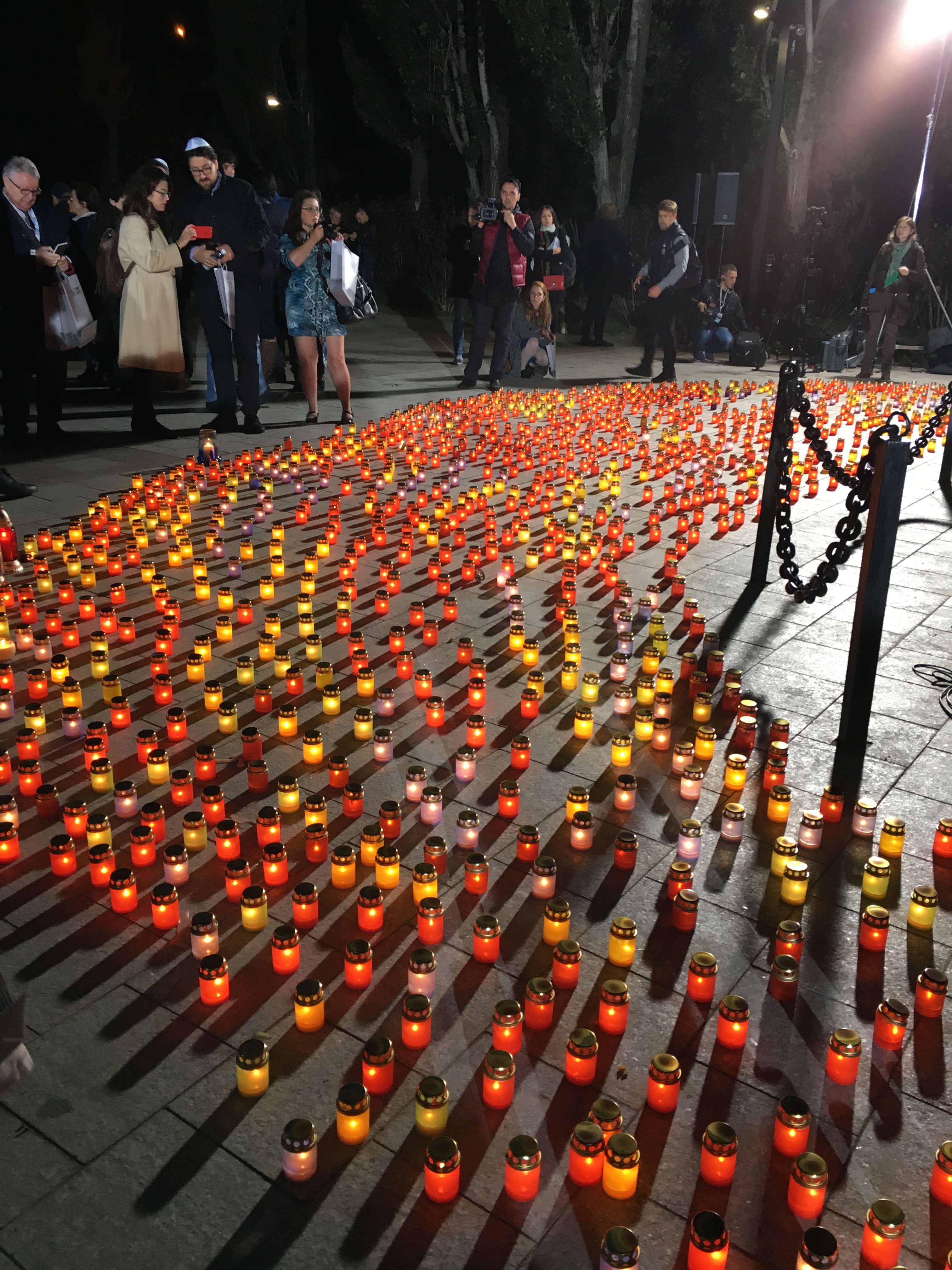Hi, everyone!
L’shanah tovah umetukah! Wishing you all a happy, sweet, healthy, and meaningful New Year this Rosh Hashanah 5777. Now’s a good a time as any for more reflection as we head full on into the High Holy Days.
I know it has been a while since I have updated the blog. I have been extremely busy the past week or so participating in commemorative events for the 75th anniversary of the Babyn Yar massacre, which I discussed in my previous post. For the most part, this included attending lectures, panel discussions, and cultural performances as part of a larger conference organized by the Canadian group Ukrainian Jewish Encounter. Participants came from all over the world – Canada, the United States, Ukraine, Germany, Israel, France, Russia, and a number of other countries. I felt like the program was comprehensive and it inspired difficult though thoughtful and productive discussion concerning the issues of Holocaust remembrance in Ukraine.

Professor of History at Yale and author of the bestselling title Bloodlands, Timothy Snyder gives the keynote address at the UJE Babyn Yar public symposium.
I also had the opportunity to cover many of the events for the Jewish Daily Forward with my Fulbright colleague Julie Seidman and wrote another piece for Foreign Policy’s Democracy Lab! The journalistic learning curve was incredibly steep and I had an enormous amount of help, not only from my co-writer and reporter Julie but from lots of other folks (shout out to Adam Whiteman and Peter Zalmayev) who helped us along the way. We had access to many high profile figures for interviews, including Volodymyr Viatroyvch (see the second link below), head of Ukraine’s controversial Institute of National Memory. I am grateful to these people and to our editors and I hope I’ll have the chance to do more work like this in the future. Here are the links if you haven’t been enticed by my barrage of social media posts:
On Babi Yar’s 75th Anniversary, a Jew Joins Forces With Ukraine’s Far Right
Ukraine’s Holocaust Dilemma: Nationalist Heroes Behaving Badly
Babi Yar at 75: How Will Changing Ukraine Remember Infamous Nazi Atrocity?
Israel’s President Confronts Ukrainians With Their Past
(This last piece got over 1,000 shares online! Woo!)
And another op-ed from another writer for the Forward that also captures the spirit and greater context of the week’s significance:
Look How Far Ukraine Has Come Since the Babi Yar Massacre
I won’t go into the nitty gritty about conference topics and the details of all the discussions that we had – but I will say a few words (okay many words, we all know I am verbose) about some of the films and cultural performances that we saw since these were not covered in my pieces. I will also say a bit on the official state commemoration, which I was able to attend unexpectedly (and am so glad I did).
In the evenings after long days of academic discussion on particularly difficult topics – and constant reminders that had my own family not left Ukraine before World War II, I probably wouldn’t exist – there were film screenings, often doubly difficult to get through. It’s easy enough to disengage from a long, winding speech or even an active panel discussion but watching a film is a different sensory experience.
One film that will stay with me forever is Boris Maftsir’s Guardians of Remembrance, a documentary film about the Holocaust in Belarus. Who talks about the Holocaust in Belarus? In my experience, not that many people. Like Ukraine, the Holocaust in Belarus is often characterized as the ‘Holocaust by bullets,’ where mobile killing units called the Einsatzgruppen traveled to towns and cities, rounded up the local Jews, and shot them all in pits (like Babyn Yar). Belarusian cities also had ghettos, there were also deportations, but for the most part, the narrative there contrasts with that of Auschwitz and Western Europe where the prevailing image is of packed rail cars and gas chambers. While a major part of the story, the concentration camp narrative is not the whole history of the Holocaust. The ability for the Nazis to kill industrially was developed on the foundation of the Holocaust by bullets and their subsequent realization that killing on such a scale was possible. They simply sought to make it more efficient. Maftsir’s interviews with Belarusian survivors tells stories that few, if any people, would hear otherwise. It was so hard to watch people, now frail from old age, recall such horrifying trauma. But it was also so important to take in. Maftsir elevated these stories in a deeply meaningful way and I hope this film will be shared widely with more and more people. Belarus is already misunderstood as a country today, closed off from the outside world by a government that parrots Soviet authoritarianism. Its history is likewise obscured and I am grateful to Maftsir (who joined us for the screening) for making this documentary.
Another film, Shoes, directed by Konstantin Fam, whose father is Vietnamese and whose mother is a Ukrainian Jew from Kharkiv, tells the story of a family in the Holocaust by only showing the shoes on their feet. In this way, inanimate objects become people and tell their tragic story with artful precision. I am not much of a film critic and do not have the vocabulary to be nit-picky about aesthetics or cinematography or the like. However, Fam’s film was incredibly, incredibly well done. For those who have visited the US Holocaust Memorial Museum in Washington, DC, you will remember the piles of shoes in the exhibit hall – everyday pieces of lives left behind in times of genocide. Every shoe had a living, breathing person inside of it. Fam builds on this idea. I highly recommend everyone to watch it if they can – it is a short film, only about 20 minutes, but incredibly powerful. Pain, loss, love, and so many other complex emotions have never been so well conveyed on screen without once showing a human face.
We also had the opportunity to attend an open rehearsal for a commemorative concert held at Kyiv’s National Opera House. The Hamburg Symphony orchestra collaborated with the Dumka choir (mentioned in the last blog post) to put on a performance that featured Brahms’ Ein Deutsches Requiem. A-ha! I know that one! It is the last piece of music I played as a member of an orchestra, in April, with the Pomona College Orchestra and Choir. As second oboist, I have to say that I mostly disliked the piece at first. Frankly, it felt boring to me. But to see it restaged in a new and deeply meaningful context resonated with me. I could follow every note and accompanying swell of emotion and it reminded me of the power of music to communicate that which words cannot. I’ll never listen to this piece again without thinking about Babyn Yar and how special it was to know the music so well beforehand.
If you’ve made it this far, bless your soul. I promise it gets more interesting (well, I think so at least)!
Earlier last week, organizers of the conference I was attending invited participants to the invitation-only state commemoration ceremony to take place Thursday (Sept 29) evening in the park near what remains of the Babyn Yar ravine. I had gone the week before to do site photographs for the Forward and saw crews erecting the massive stage and stands for the event. I fully expected to sit this one out but when the opportunity arose to get the tickets, I couldn’t say no to this chance to be a part of something historic.
I left an hour and a half before the start time to get across the city in rush hour traffic and go through security (heavy security, I will add). Sometimes, things happen in Kyiv that defy logic – I ordered a cab and the driver managed to slog through gridlock across the city with his gas gauge on empty. I was white-knuckled, thinking I would have to sprint a kilometer or five in my suit to make it on time. Alas, our hero driver defied science and I made it. (I tipped generously, though hesitated at first when I realized he picked me up with no gas in his car.)
A new installation in the park, built especially for the commemoration, included information stands that shared step-by-step history of the tragedy and noted the particularity of targeting Jews, especially in the first chapter of Babyn Yar’s history as a killing site. Volunteers at the entrance to the venue handed out kippot, or traditional skullcaps, for all the men to wear.

There were at least 1,500 people in attendance, including President of Ukraine Petro Poroshenko, the German foreign minister, US secretary of commerce, other heads of state (including the President of Hungary Viktor Orban whose Jobbik party has been accused of anti-Semitism…interesting), and countless other dignitaries and figures from civil society organizations across the world. Moving speeches were made. President Poroshenko showed his unwavering commitment to the cause of remembering the Holocaust in Ukraine as both a Jewish tragedy and as an inseparable part of Ukrainian history. The National Philharmonic of Ukraine played the score from Schindler’s List followed by a performance of Bernstein’s Chichester Psalms. A little boy stood at the front of the stage and his innocent, soprano voice carrying the words of the 23rd Psalm in Hebrew brought everyone to tears. For the first time in a difficult week of confronting painful history, I sobbed uncontrollably. Later, Chief Rabbi of Ukraine Yaakov Bleikh led the crowd in Kaddish, or the Jewish prayer for the dead.
How does one say Kaddish for 33,771 souls (or 100,000 if we include all lives lost at Babyn Yar over the course of the war)? You could say Kaddish at Babyn Yar 50 times a day every day for 5 years and still not say it for every person who was killed there.
At the event’s conclusion, the President led a procession out of the arena to the edge of the ravine where the black menorah, erected in 1991, stands to commemorate Kyiv’s murdered Jews. Everyone was given a pre-lit candle to place at the menorah’s base and the entire monument was awash in flickering light.


I had felt it now and again over the course of the week, but looking at all the candles and all the people who had come to commemorate Babyn Yar, I felt a true, inspiring sense of hope for Ukraine. The country has a long way to go on so many fronts but the well-coordinated, government-supported memorial service shows just how far Ukraine has already come.
Next post to come later this week: a look at the Rosh Hashanah Hasidic pilgrimage to Uman. Also perhaps a word or two or 5,000 on the process of getting one’s visa registered with Ukrainian immigration services. And that, my friends, is another megillah entirely. Stay tuned.